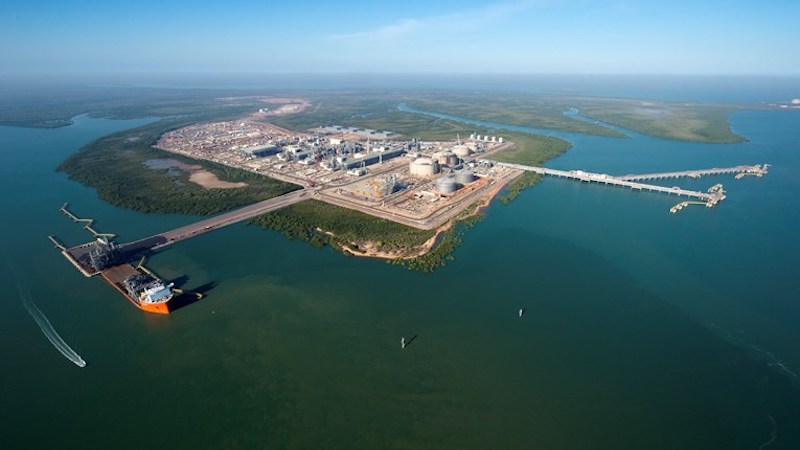Australia’s greenhouse gas emissions rose in the year through March largely due to increased liquefied natural gas output, the government said on Friday, adding that without LNG, the country’s emissions would have fallen.
Greenhouse gas emissions rose 0.6% to 538.9 million tonnes of carbon dioxide equivalent (CO2-e) from the previous year, mainly due to a 19% rise in LNG exports and growth in steel and aluminium production, the government said in a quarterly greenhouse gas update.
LNG output added 4.7 million tonnes CO2-e, more than offsetting a 2.1% drop in emissions from the electricity sector, the biggest source of carbon emissions, as the growth of wind and solar power has reduced the use of dirty coal.
Emissions were 11.7% below their 2005 level, with about 11 years to go to meet Australia’s commitment under the Paris climate accord to slash emissions by at least 26% from 2005 levels by 2030 to help combat global warming.
Australia’s emergence as the world’s top LNG exporter has created a quandary for the conservative government, as methane and carbon emissions from gas and LNG production make it harder for the country to meet its greenhouse gas emission targets.
At the same time, Canberra has praised the benefits of the LNG export industry and its role in helping cut emissions in the countries that buy the LNG. The government claims the gas replaces dirtier coal-based energy in those countries.
“Australia’s LNG exports for the year to March 2019 are estimated to be worth A$47.8 bln ($32 billion) and have the potential to reduce global emissions by up to 152 Mt CO2-e, or up to 28% of Austrlaia’s annual emissions,” Energy and Emissions Reduction Minister Angus Taylor said in a statement.
The emissions footprint from the LNG industry should improve over the next year. The recent start-up of carbon capture and storage at Chevron Corp’s Gorgon LNG project off Western Australia will bury up to 4 million tonnes of emissions a year.
Climate Home News needs your help… We’re an independent news outlet dedicated to the most important global stories. If you can spare even a few dollars each month, it would make a huge difference to us. Our Patreon account is a safe and easy way to support our work.
The process involves removing CO2 from the gas that Chevron produces from the Gorgon project at Barrow Island, and injecting it through wells into reservoirs under the ocean floor, 2 km (1.2 miles) below the island.
Also on Friday, the Great Barrier Reef Marine Park Authority (GBRMPA) downgraded the reef’s status to the lowest level, which could jeopardise its World Heritage listing.
The agency said the health of the world’s largest coral reef system, off the northeast coast of the state of Queensland, had deteriorated since its last review in 2014, but the problems the reef faced were not insurmountable.
“This report draws attention to the fact that the outlook for the Great Barrier Reef, the long term outlook, is very poor- that’s largely driven by climate change,” GBRMPA’s chief scientists David Wachenfeld told reporters in Sydney.
“Despite that, with the right mix of local actions to improve the resilience of the system and global actions to tackle climate change in the strongest and fastest way possible, we can turn that around.”
Climate news straight to your inbox? Sign up here
The report, which is compiled every five years, painted a deteriorating picture of widespread coral bleaching, habitat loss and degradation caused by human-induced climate change, overfishing, poor water quality, and coastal land clearing for grazing.
Some parts of the reefs remained in good condition but many species including dolphins, dugongs, sharks, rays and turtles were being threatened.
Unesco’s World Heritage Committee last year called for global action on climate change to protect five large coral reefs, including the Great Barrier Reef.
The committee is due to consider the reef’s heritage listing, considering its health and a possible “in danger” status.
“The Great Barrier Reef is one of the globe’s most famous World Heritage Areas yet the report finds that its integrity is challenged and deteriorating,” environmentalist group Australian Marine Conservation Society said in a statement.
“This is now the third outlook report. We’ve had ten years of warnings, ten years of rising greenhouse emissions and ten years watching the reef heading for a catastrophe,” said the group’s director of strategy Imogen Zethoven.
“This report will be a major input into Unesco’s committee and here is a very strong case for the reef to be considered for the in danger list.”
The inclusion of the reef on the in danger list would be an embarrassment for the government and could damage the tourist industry.
Unesco’s chief of the Asia and Pacific region, Feng Jing, said the organisation was following closely the state of the reef and progress made in protecting it and would consider its status in July next year.
“We would hope that the collective efforts undertaking by the State Party of Australia will bring the change that is needed to ensure the sustainable conservation of the Great Barrier Reef,” Jing said in an emailed statement.
